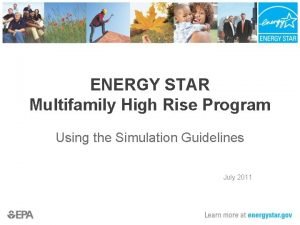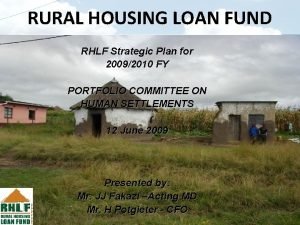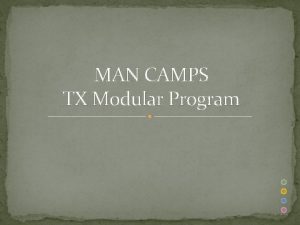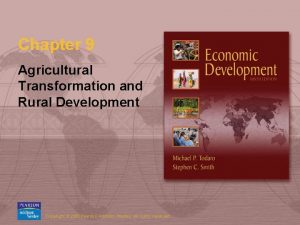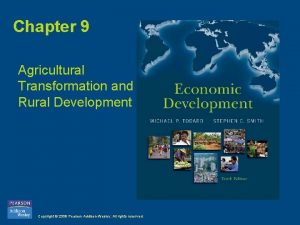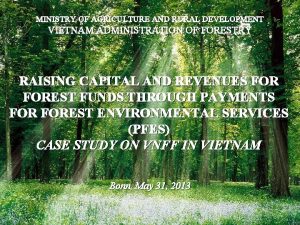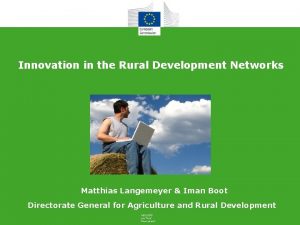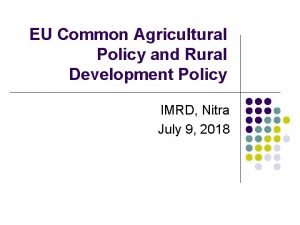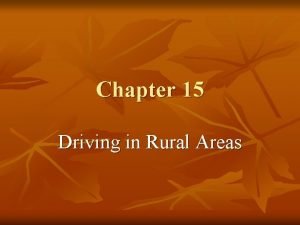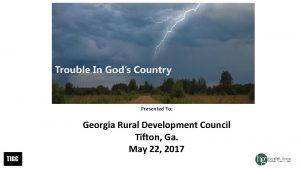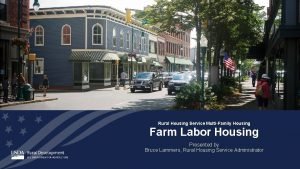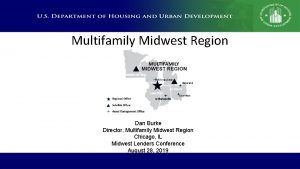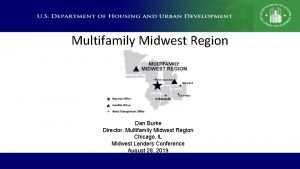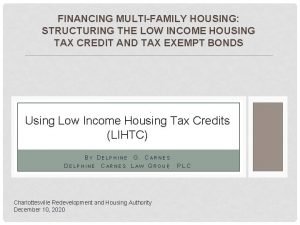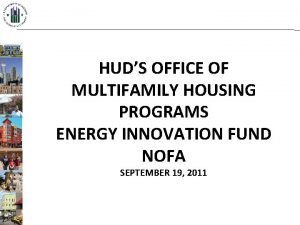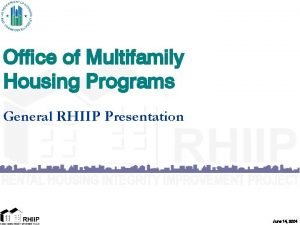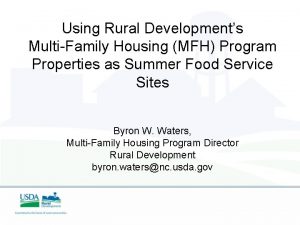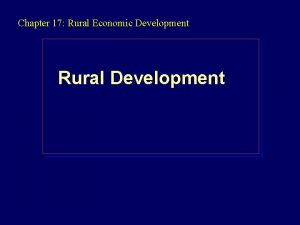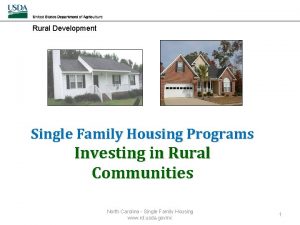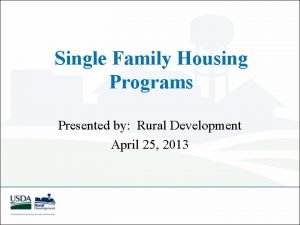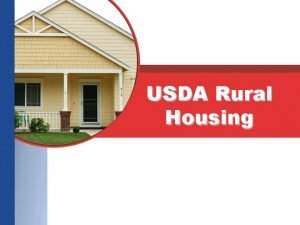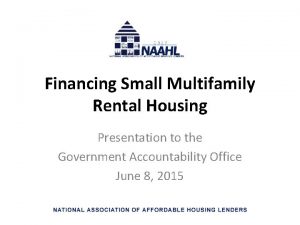Texas Rural Development Rural Development Programs MultiFamily Housing


















- Slides: 18

Texas Rural Development


Rural Development Programs Multi-Family Housing Single-Family Housing Rural Business and Cooperatives Community Facilities Rural Utilities Service

Overview of the Direct Section 515 Program

Multi-Family Housing Direct Loans

Multi-Family Housing Direct Loans Continued…

History of Multi-Family Housing Programs 1934 The Rural Rehabilitation Division was established to make loans to destitute farm families, enabling them to remain on the land to continue their farming operations. This lending agency for farmers, the first of several, had few basic laws to govern its actions. 1935 The Resettlement Administration took over the duties of the Rural Rehabilitation Division and made lending to farmers more systematic. 1937 The Farm Security Administration (FSA) succeeded the Resettlement Administration, and continued its duties under the formal supervision of the U. S. Department of Agriculture. Two existing farm labor housing properties were among several financed by the Farm Security Administration in the early 1940’s, in southern Florida. First Lady, Eleanor Roosevelt cut the ribbon to open the property in Belle Glade, Florida. The other project in Homestead, Florida has eight of the original units still in service after 50 years of operation and repair after destruction by Hurricane Andrew. 1946 The FSA was restructured, and renamed Farmers Home Administration (Fm. HA) under permanent status authorized by the Farmers Home Administration Act. This new agency and the authority both to make direct government loans for farm rehabilitation and ownership and to insure farm loans made by other agencies. 1949 Title V of the Federal Housing Act of 1949 gave Fm. HA authority to make housing loans to farmers, as part of the national housing program. The Housing Act of 1949 remains today as the primary federal statute establishing Fm. HA Multi-Family Housing programs. As a result of the Housing Act, we have Section 502 for interest credit and prepayment, Section 514 and 516 for labor housing loans and grants. Section 515 for rural rental housing, Section 521 for Rental Assistance, Sections 523 and 524 for site loans and Section 533 for housing preservation grants. 1961 The Housing Act of 1949 was amended to make all rural residents, rather than just farmers, eligible for direct housing loans. The program name changed to “Rural Housing” and projects in towns of up to 2, 500 population became eligible for loans.

History of Multi-Family Housing Programs Continued… 1962 The Senior Citizens Housing act set up loans for low-rent apartment projects designed to meet the needs of people age 62 and over. (This type of housing was acutely lacking in rural communities. ) The MFH Program eventually began during the early sixties after the passage of this legislation. The first loans are sometimes referred to as “direct” loans and were primarily used to fund small rental projects. The first direct loan was for $182, 000 to finance 31 apartments units in the small farming community of Grove City, Minnesota. Local residents formed a non-profit corporation to build and operate this project for the elderly. The housing is still in use. 1965 The Rural Housing Program expanded, and changed from a program of direct rural housing loans to one of insured loans, funded by the Rural Housing Insurance Fund (RHIF). At this point, the population limit on towns served through Fm. HA was raised from 2, 500 to 5, 000. 1966 Senior citizens and younger low-income families became eligible for Fm. HA rural housing loans or tenancy in rural rental housing. 1968 Title VIII, of the Civil Rights Act of 1968 was passed, which prohibited discrimination in the provision of housing on the basis of race, color, religion, sex or national origin. 1970 Fm. HA increased its cooperative efforts with other lenders and the population limit was raised to 10, 000 for a rural community seeking an Fm. HA housing loan. 1972 The Rural Development Act gave USDA primary responsibility for Federal rural development activities, which are run by Fm. HA, Rural Electrification Administration (REA, and Rural Development Service (RDS). 1973 Section 504 of the Rehabilitation Act of 1973 prohibited discrimination against persons with disabilities in federally- assisted programs.

History of Multi-Family Housing Programs Continued… 1974 The Housing Act of 1949 was amended. Some of the major changes were to: Extend Fm. HA housing loan services to towns of 10, 000 to 20, 000 population and to all U. S. Island Territories. Authorize USDA to begin a rental assistance program, which would complement Department of Housing and Urban Development’s (HUD) tenant rent subsidy program in urban areas. USDA adopted Fm. HA as the acronym for Farmers Home Administration, to reduce confusion with other Federal agencies bearing similar initials. Funding for MFH Programs greatly increased throughout the seventies. 1976 The fiscal year for federal funding was changed from July-June to October-September. 1977 The Rental Assistance program was implemented and made available to eligible tenants. RA was provided in 5 year and 20 year agreements (contracts). 1978 The White House initiated a Congregate Housing pilot program. Eleven housing properties were funded nation-wide to see if this concept for housing elderly tenants would be successful. 1978 - 1980 The District Office was introduced and its role was expanded during this period to provide a greater level of service to the expanding MFH, Community Programs and Business and Industry (CP&BI) programs. 1980 Instructions 1930 -C (asset management), 1944 -E (loan processing) and 1944 -L (tenant grievance) were published for the first time as official Federal Register documents. The last 20 year RA units were obligated during FY 1982, as well as the last Section 515 property with HUD Section 8 units tied to them for 20 years. 1982 1983 Amendments to the Housing Act, created changes in the single-family and multi-family housing programs of Fm. HA. The new legislation directed Fm. HA to give priority to serving very-low income households and making its housing assistance more affordable to low income persons in rural areas. The law required that Fm. HA revise its income definitions to be consistent with HUD’s and to also accept any of the voluntary national model building codes and HUD minimum property standards, in addition to the Fm. HA construction standards.

History of Multi-Family Housing Programs Continued… 1985 Automated Multiple Housing Accounting System (AMAS) was implemented to provide improved automated financial support to the MFH program. Fm. HA Instruction 1951 -K was established to provide guidance on AMAS. Thus, many forms were revised or instituted to accommodate the changes. Changes to the tax laws established “tax credits” which allow borrowers incentives for providing housing to low income tenants. IRS guidelines are used to determine eligibility for the amount of tax credits a borrower may receive. 1987 Housing and Community Development Act required Fm. HA to offer a borrower incentives to encourage borrowers to retain 515 Housing under the MFH Program. The goal is to preserve low-income housing for its original purpose. This act was designed to protect low-income and elderly tenants from being displaced when a borrower prepays. The Agriculture Credit Act changed the structure and the way appeals were conducted with Fm. HA. It set-up an independent appeals unit, the National Appeals Division (NAD). 1988 The Fair Housing Amendments Act of 1988 expanded the scope and enforcement of Title VII of the Civil Rights Act of 1968, by prohibiting discrimination against persons with disabilities and families with children. The Multiple Tenant File System (MTFS) was implemented to assist the Servicing Office with reviewing and approving tenant certification and project worksheets. 1994 The Rural Economic and Community Development (RECD) Mission area was established, with the enactment of the Federal Crop Insurance Reform and Department of Agriculture Reorganization Act. This legislation established seven mission areas within USDA based upon the primary missions of the Department. RECD was one of the mission areas. 1995 Rural Housing and Community Development Service (RHCDS), was changed to Rural Housing Service (RHS), in response to internal and external complaints regarding the long and often cumbersome agency name. The Multi-Family Information System (MFIS) was implemented. This system is the management database that monitors the management of the MFH program.

History of Multi-Family Housing Programs Continued… 1996 With the Congressional passage and Presidential signing of the Farm Bill, the mission area name for Rural Economic and Community Development (RECD) was changed to Rural Development mission. 1997 November 18 – change in the statutory maximum loan term from 50 to 30 years. For new construction loans, the loan terms are 30 years, with payments amortized for 50 years. For rehab loans, the loan term is 30 years or the remaining economic life of the project, with an amortization period of 50 years or the remaining economic life, whichever is less. 1999 The Office of Inspector General (OIG) and RHS combined efforts on a nationwide Initiative to identify owners and management agents that misused funds while neglecting the physical condition of the MFH program. 2001 Implemented Site Manager of Year Award (in 2015 included Maintenance Person) 2004 A Comprehensive Property Assessment (CPA) was completed. The Department determined that the portfolio of Section 515 properties was in such condition and of such concern that an assessment of the situation was imperative. The CPA was initiated using outside consultants to do the following: 1. Review issues and develop solutions directly pertaining to the market demand for such housing. 2. Review and define potential approaches to address the increasing propensity for owners to prepay RD subsidized loans and thereby displace needy tenants. 3. Analyze and develop solutions for the increasing rehabilitation and recapitalization requirements of the aging existing properties. 2005 On February 24, 7 CFR 3560, “Reinvention of the Sections 514, 515, 516 and 521 Multi-Family Housing was implemented as an “Interim Final Rule” The regulation combined 14 regulations.

History of Multi-Family Housing Programs Continued… 2006 Beginning in FY 2006, Congress appropriated funds for Rural Development two “demonstration” programs Multi-Family Housing Revitalization Demonstration program (MPR) o The primary restructuring tool to be used in this program is debt deferral up to 20 years o Revitalization Grant: o Revitalization Zero Percent o Soft-Second Loan: RD Voucher Program (Section 542) – which provides residents of prepaid or foreclosure MFH properties a subsidy similar to the HUD Choice Voucher program. The Voucher is “mobile” for the resident to take to any landlord. 2007 All MFH’s Tenant Certifications and Payments processing was moved to the Customer Servicing Center. (CSC) 2009 Implemented Disaster policies 2013 Sequestration (the automatic spending cuts) reduced the RA budget by approximately $65 million. Payments of RA were not able to be made to approximately 300 borrowers. RA Relief Plans were implemented to defer mortgage payments, withdraw funds from reserve account, defer return to owner and/or borrower infused funds into the project. 2015 Implemented IPADs for Supervisory Visits and Physical Inspections 2015 An update to the 2004 Comprehensive Property Assessment was started. A critical new component is a focus on energy conservation. 2015 Beginning in FY 16 – RA renewal obligations were funded at the project level instead of using a state per unit value.

Direct Section 515 and Section 514 National Portfolio 13, 961 apartment properties 425, 705 apartment units 2. 0% delinquency All data as of 12/31/2017

Direct Section 515 and Section 514 Texas Portfolio 662 apartment properties (most in the Nation) 23, 391 apartment units 3. 8% delinquency All data as of 12/31/2017

Direct Section 515 and Section 514 National Portfolio Compared to the Texas Portfolio 13, 961 National vs. 662 Texas apartment properties 425, 705 National vs. 23, 391 Texas apartment units 2. 0% National vs. 3. 8% Texas delinquency All data as of 12/31/2017

Policy Map Direct 515 Properties

Resources There is no open NOSA for this program at this time https: //www. rd. usda. gov/tx https: //www. rd. usda. gov/programs-services/all-programs/multi-family-housing-programs https: //eligibility. sc. egov. usda. gov/eligibility/welcome. Action. do https: //www. policymap. com/

Questions Any Questions?
 Multi housing direct
Multi housing direct Solar on multifamily affordable housing
Solar on multifamily affordable housing Solar on multifamily affordable housing
Solar on multifamily affordable housing Multifamily radon testing
Multifamily radon testing Energy star multifamily high rise
Energy star multifamily high rise Energy star multifamily
Energy star multifamily Cbre chicago multifamily
Cbre chicago multifamily Cpmcd in software engineering
Cpmcd in software engineering Rural housing loan fund
Rural housing loan fund Single family housing section 504 repair pilot program
Single family housing section 504 repair pilot program Texas industrialized housing and buildings program
Texas industrialized housing and buildings program Chapter 9 agricultural transformation and rural development
Chapter 9 agricultural transformation and rural development Chapter 9 agricultural transformation and rural development
Chapter 9 agricultural transformation and rural development Ministry of agriculture and rural development cameroon
Ministry of agriculture and rural development cameroon Ministry of agriculture and rural development vietnam
Ministry of agriculture and rural development vietnam Rural development
Rural development Rural development
Rural development Chapter 15 driving in rural areas
Chapter 15 driving in rural areas Usda rural development tifton ga
Usda rural development tifton ga




